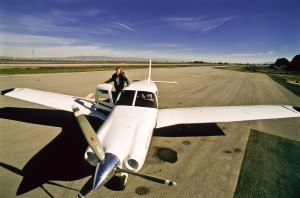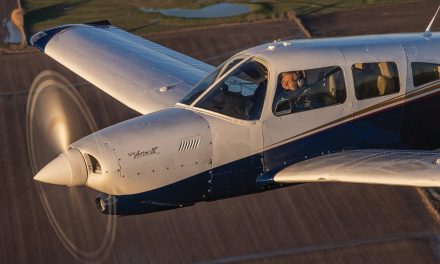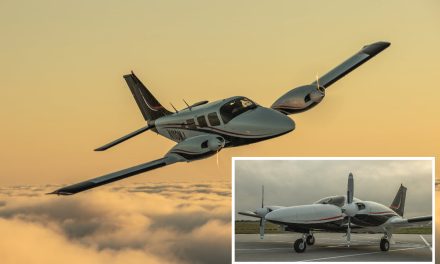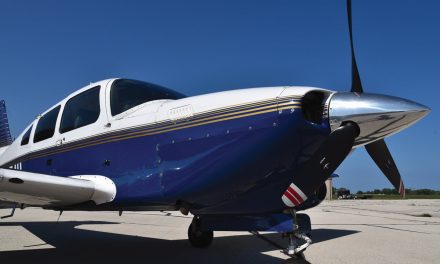 Featured Plane
Featured Plane
Saratoga
Piper’s Six-Seat Entry-Level Limo
Forget the Conestoga nickname. The Piper Saratoga was a first-class traveling machine.
Since the first Piper Lance was sold back in 1976, I always regarded the concept of a retractable Cherokee Six as a great idea. The first, fixed-gear Six 260 and Six 300 had been excellent sellers from their introduction several years earlier, and it’s no wonder.
They could carry pretty much anything you could close the doors on, they were supremely comfortable airplanes to fly, and they did a job few other models could manage. Lances offered the largest cabins in the class, especially in contrast to the vaunted A36 Bonanza that made do with a 42-inch cross section. The Saratoga HP boasted a 49-inch passenger cabin, and believe me, that extra six inches seemed like a lot more.
The Lance offered another advantage over the competition, a separate, forward baggage compartment. If there was something you didn’t need access to in flight but wanted to keep warm during your trip, you could stow up to 100 pounds of whatever in a convenient space between the engine firewall and the forward cabin. Positioning that compartment directly behind the big Lycoming virtually guaranteed you’d arrive with warm baggage up front—a not inconsiderable advantage in winter. A peripheral benefit was that the empty or full space directly in front of the cabin helped dampen the decibel count of the engine in flight.
The Piper Seneca that premiered in the early 1970s also utilized the basic Cherokee Six fuselage. Between 1976 and 1979, I had a company Seneca II that featured the same cabin, and I was occasionally called upon to fly a Piper Lance to transport company executives around the Golden Triangle of the Northeast. The folks I carried were decision makers who knew practically nothing about airplanes, but quite a bit about the magazine business. They were sometimes hard-pressed to tell the difference between riding in the Seneca or Lance.
The retractable Saratoga began life as the Lance, and it was an immediate hit with pilots all over the world. The PA-32R Lance used the 4570-pound Seneca’s gear system, a feature that virtually guaranteed you could take a 3600-pound Saratoga places you wouldn’t think about flying another six-seat, single-engine retractable. Plus, the airplane was generally built tough. Though never designed as a bush bird (few retractables are suited to the demands of backwoods flying), the Lance could do the job on semi-smooth dirt strips, and the twin, aft left cargo doors made it an easy airplane to load.
Power on all the Lances and Saratogas was provided by pretty much the same reliable 300-hp Lycoming used on the fixed-gear Cherokee Six. In fact, the retractable was nearly identical to the fixed-gear model from the floorboards up.
In 1977, Piper decided T-tails were stylish and began equipping as many of their models as possible with a horizontal stabilator mounted high up on top of the vertical tail. Unfortunately, T-tails aren’t suited to installation on all airplanes. They’re ideal for lifting the horizontal tail up out of the wash of the prop at high angles of attack. This makes some designs less prone to pitch changes associated with power adjustments. Jets with tail-mounted engines nearly all use T-tails for that reason.
Though the T-tail worked reasonably well with Piper’s twin-engine Seminole trainer, an airplane that’s still in production today, it was only a modest success on the Arrow, was tried and never adapted to the Seneca, and only lasted three years on the Lance. Pretty obviously, one negative was the need to builder a stronger vertical tail to support the extra weight and bending moment of the high tail surface.
Part of the problem was that the Lance’s empennage utilized the horizontal stabilator from the Cherokee 140 which was too small to support the much larger and heavier Lance. The idea was that the smaller control surface would create less drag, and might allow better cruise speed. The best laid plans…. The resulting airplane simply didn’t have enough elevator authority. It used more runway than the original Lance, had slightly more adverse stall characteristics, and was not well received on the market.
Piper attempted to salvage the Lance II by installing the original, low, Cherokee Six stabilator. The company completed flight tests, earned certification from the feds, and Piper even printed thousands of new brochures before concluding the airplane’s image had been too severely damaged to salvage. The company cancelled production at the last minute, ditched the name, Lance, and introduced the airplane as the Saratoga which included the original low tail and the semi-tapered, Warrior wing to give the airplane a more modern appearance.
The PA-32 continued in production through 2008 in the same basic configuration, though there were numerous equipment, paint, and upholstery changes over the following quarter-century. Along the way, the Saratoga adopted turbocharging, air conditioning, TKS, and a variety of other features to add luxury and safety to what was already an extremely capable airplane.
When the company finally shut down production of the PA-32 in 2008 as the U.S. economy began to slide downhill, some 7200 airplanes of all types—including fixed gear and retractables, normally aspirated and turbocharged—had been delivered. The final Saratoga II HP became a favorite of pilots with big families and small companies with a need for fast travel between destinations as much as 800 nm apart. The final price for the Saratoga II HP in 2008 was $573,000.
I’ve been fortunate to spend several hundred hours in a variety of Lance/Saratogas over the last 35 years and have delivered a dozen of the type to Europe, Africa, and Australia. Plus, I’ve flown another two-dozen or so in the lower 48. By far, the largest single block of Saratoga time was in a new 2002 model. I picked up the airplane at the Piper factory in Vero Beach and flew to the Oshkosh airshow to show it off to the new owner who visited Oshkosh on the annual Qantas 747 charter direct from Sydney. I then flew it to the West Coast for tanking before finally ferrying it across the Pacific to its new owner in Melbourne, Australia.
I’ve flown the Pacific in a variety of aircraft, but the latter trip was one of the most comfortable I’ve made. The airplane was tanked with an extra 250 gallons of fuel, bringing total capacity to 352 gallons. In combination with all my survival gear, HF radio, and other equipment, the HP’s total ferry weight was about 4400 pounds—roughly 800 pounds over its normal 3600-pound gross weight (operating under a ferry permit with a special airworthiness certificate). That’s about 22 percent over gross and not far from the feds’ 25-30 percent limit for ferry flying, but the airplane obviously hadn’t read the restrictions in the ferry permit!
Since I’d previously taken a Lance to Africa at roughly the same weight, I wasn’t surprised that the HP did a good job of handling the extra weight. Despite the overload, climb was a fairly strong 800 fpm, and the airplane manifested the same stable attitude I’ve come to enjoy from other PA-32s. If I’d needed to fly at 10,000 feet initially, the airplane would have obliged, but the wind is almost never favorable for that altitude off the West Coast. Winds usually start off as headwinds, then, gradually shift around the compass to tailwinds later in the flight.
(Weight is a consideration in ferry flying, but CG is by far the more critical concern. If the CG is maintained somewhere near the center of the envelope you can fly with a ridiculous amount of weight. The late Max Conrad once flew non-stop from Casablanca, Morocco, to Los Angeles in a Comanche at nearly 100 percent over gross. On takeoff from Casablanca, his Comanche was loaded with 500 gallons of fuel. In normal operation, a Saratoga is more likely to have forward CG problems than aft CG issues. That can happen when the airplane has burned down to minimum fuel with two lightweight pilots up front but no rear passengers or cargo load. Aft CG problems aren’t nearly as difficult. If you do wind up with a CG outside the aft envelope, you can sometimes solve it by loading some of what normally would be cabin weight into the forward cargo compartment.)
On the first leg from Santa Barbara to Honolulu, I filed for 6000 feet initially to minimize the effects of the headwind. Then, after burning down fuel for about six hours and watching the wind make its clockwise spiral around toward the tail, San Francisco cleared me to 10,000 feet. Two hours out of Honolulu, I drifted up to 12,000 feet and crossed Molokai at 185 knots while enjoying a strong 25-knot push.
Under more normal circumstances, I’ve seen about 160-165 knots cruise in no-wind conditions. That’s pretty much the limit for a normally-aspirated Saratoga II HP. The subsequent 2000-mile leg down to Majuro, Marshall Islands, went well with help from prevailing trade winds speeding me toward Australia at nearly 190 knots.
What the Saratoga does best is provide a semi-quiet, sublime ride for all onboard, while allowing good visibility, reasonable stability, and a roomy cockpit environment. If you did download fuel sufficient to carry six people, your passengers would appreciate the airplane’s generally smooth ride and resistance to turbulence.
Landings are similarly simple. As with most of the big singles, favored technique is to fly it like a twin—ease the airplane down into the flare with power, then back off the throttle and allow the Saratoga to settle onto the ground. Despite the airplane’s weight (or perhaps because of it), the stall is fairly benign with no surprises. The Saratoga’s oleo gear system absorbs even rough touchdowns and makes most pilots (especially this one) look like the pros they wish they were.
It’s a sad reality that Saratogas didn’t survive the 2008 recession. For most of us who felt the PA-32 may have been the all-around best of the six-seat, piston retractables, Piper’s premier, unpressurized single has a special place in the business/utility aircraft hall of fame.
Specifications & Performance – 2008 Piper Saratoga II HP
All specs and performance numbers are drawn from official sources, often the aircraft flight manual or the manufacturer’s web site. On used aircraft, common sources of information are Jane’s All-The-World’s Aircraft or RVI’s Aircraft Bluebook Price Digest.
Specifications
Used Price: $405,000
Engine make/model: Lyc IO-540-K1G5D
Horsepower@altitude: 300
Horsepower on takeoff: 300
TBO – hours: 2000
Fuel type: 100LL
Propeller: Three-blade/CS
Landing gear type: Ret/retr
Gross weight (lbs): 3600
Std empty weight (lbs): 2411
Useful load – std (lbs): 1189
Usable fuel – std (gal/lbs): 102/612
Payload – full std fuel (lbs): 577
Wingspan: 36’ 2”
Overall length: 27’ 8”
Height: 8’ 6”
Wing area (sq ft): 178
Wing loading (lbs/sq ft): 20.2
Power loading (lbs/hp): 12.0
Wheel size: 6.00 x 6
Seating capacity: 6/7
Cabin doors: 2/3
Cabin width (in): 49
Cabin height (in): 42
Performance
Cruise speed (kts): 75% 166
Fuel Consumption (gph): 75% 17
Best rate of climb, SL (fpm): 1305
Maximum Operating Altitude (ft): 15,588
Stall – Vso (kts): 63
TO ground roll (ft): 1200
TO over 50 ft (ft): 1770
Ldg ground roll (ft): 640
Ldg over 50 ft (ft): 1520





